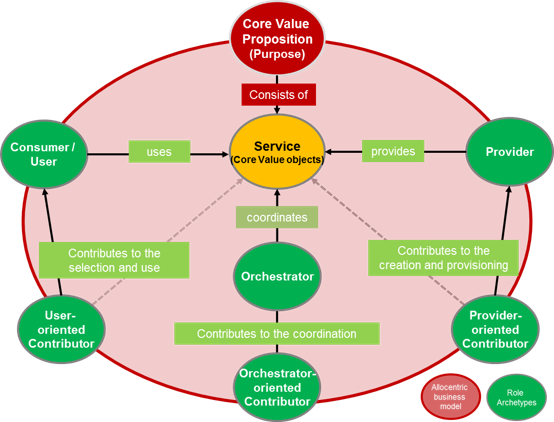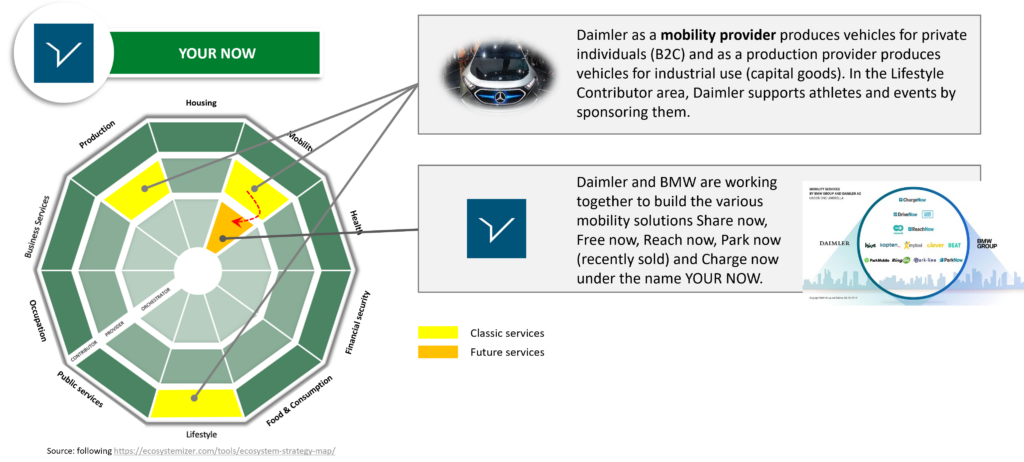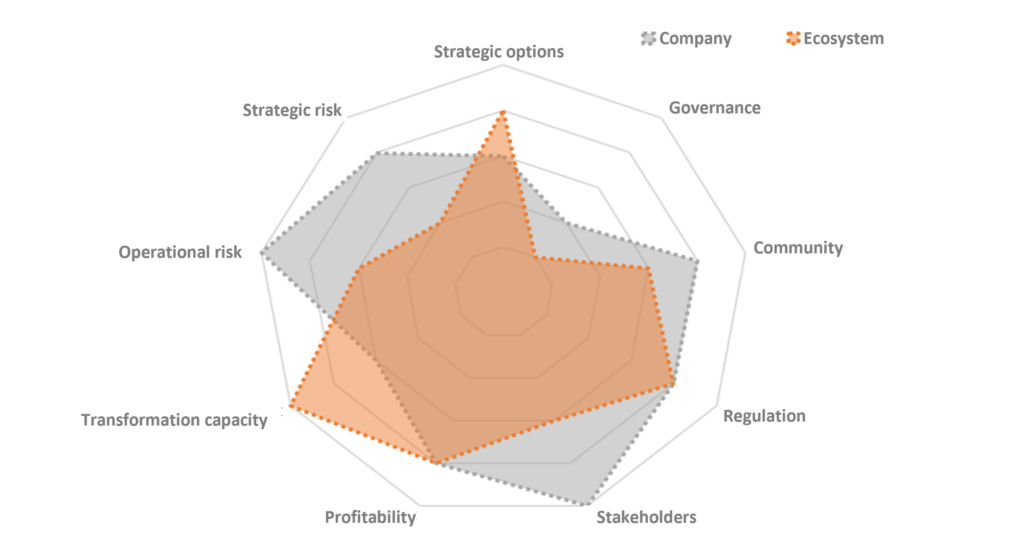
How to Choose Which Ecosystem to Participate In
At the beginning of every purchase decision there is a need. As long as my need is satisfied, my problem solved, the individual product doesn’t play such an important role for me as a customer. And the easier I can solve a problem, the less time and energy I have to invest in solving it, the better. Against this background, it is not surprising that customer needs are now increasingly being met by integrated services provided jointly by several companies, covering a need much more comprehensively than one company could. The fact that cross-industry collaboration between different companies is possible at all is a consequence of digitalization.
Digitalization and Ecosystems
The effect of digitalization can be illustrated, among other things, by the example of Amazon[1]. Initially, Amazon digitized its sales and offered products via the Internet. Later, it also digitized content that had previously been tied to a physical form, such as books and CDs, which could now also be consumed digitally. It thus used information technology to optimize existing value creation structures. This step alone made it possible to realize forms of cooperation, such as the Amazon Marketplace. In the next stages of development, information technology was then used to generate completely new value creation structures. These include, for example, the cloud services offered by Amazon, but also the financing of merchants who offer their products on Amazon. The transaction data available to it enables Amazon to estimate the creditworthiness of its merchants quite well. In 2017 alone, Amazon disbursed loans in the segment of smaller corporate loans between $1,000 to a maximum of $750,000 with a volume of more than $1 billion in 2017, thus becoming a significant competitor in the corporate loan segment.[2]
As this example shows, Amazon’s success is not based solely on the digitization of the customer interface. Today, this is still an important prerequisite for potentially reaching more customers or not losing contact with existing customers, but it has long since ceased to be a competitive advantage. Instead, it is crucial to discover and exploit new business opportunities made possible by digitization – this means, above all, a shift to multilateral business models. What is meant by this is that a company places its services in one or more different networks and also in different contexts – an insurance company, for example, could not only sell its products via its own website, but embed them in the sense of embedded finance in customer journeys in which they are needed, such as when renting a scooter or bicycle with a pay-per-use concept or when purchasing high-quality consumer goods online or in a store. At the same time, it could also offer its products via comparison portals. This way, many more customers can be reached via the networks – possibly with the same services – and integrated solutions can also be made available by combining different products and services from different companies. The customer can thus be offered a much more innovative and comprehensive value proposition, even if the offering of the individual companies involved essentially does not change.
Major challenges faced by companies can be addressed by tapping into ecosystems. Increased customer demands can be satisfied by more comprehensive and innovative solutions, whereby the degree of innovation does not only result from the bundling of different services, but also from the analysis of transaction data and consequently a greater personalization of the offers. In particular, consumers, providers and contributors benefit from the infrastructure provided by the orchestrator without having to build their own technological capabilities, while orchestrators can share the costs and risks of developing an ecosystem through collaborations (such as originally Daimler & BMW). In addition, participation in ecosystems offers new revenue opportunities through access to a much broader customer base, possibly also through the development of innovative revenue models. Ultimately, through direct and indirect network effects, each ecosystem participant benefits from the participation of all other partners in the ecosystem.
How significant are such networks or ecosystems? According to estimates, about seven of the ten largest companies worldwide pursue ecosystem approaches. In addition, the companies listed in the S&P 500 with the highest growth rate most strongly follow the ecosystem concept.[3] By 2025, 30% of global revenue is expected to be generated in ecosystems[4], and 76% of executives expect ecosystems to be the primary driver of changing business models.[5]
But how do you decide whether to participate in an ecosystem or to build one yourself and – even more challenging – how do you put this decision into practice? First of all, it is absolutely necessary to build up an understanding of what constitutes an ecosystem, how it works, and what roles there are in an ecosystem. Based on this, the next step is to evaluate which specific ecosystems would be interesting for your own company and which roles you can realistically assume based on your own capabilities and those of the competition.
We have already written elsewhere about how ecosystems work and the roles available to companies looking to participate in an ecosystem. For those who are new to the topic or would like to briefly recall the contents, we have summarized the most important points under the following two subheadings:
Ecosystems BasicsIn principle, ecosystems can be regarded as dynamically developing value networks of a wide variety of participants with a common organizational and transactional infrastructure. The players are autonomous but interdependent. Their business model serves collaborative value creation with an overarching goal. Often, this collaborative value creation is orchestrated via a digital platform that provides the infrastructure for developing and / or exchanging services. Thus, a platform cannot be equated with an ecosystem, even though it is often an important means of orchestrating one, and is often the starting point for the development of an ecosystem, for example, when a comparison platform begins to open up to additional participants and services that fit its value proposition. Basically, different roles can be identified that a company can take on in an ecosystem.[6]
Four archetypal roles can be distinguished when it comes to collaborative value creation within an ecosystem. Consumers/users use a core service, i.e., resources and resource bundles in the form of services and products. Orchestrators coordinate services between participants by controlling and regulating the associated value flows. Providers provide benefits, i.e., resources and resource bundles in the form of services and products in the ecosystem. Finally, contributors support consumers, providers, and orchestrators with sub-services in the use, provision, and coordination of the core service.[6]

The core value proposition can be simplistically interpreted as the shared vision of the ecosystem participants. It justifies why an ecosystem exists. Here, a fundamental distinction can be made between the goal of resolving “pain” and the goal of achieving “gain”.[7] Examples of resolving pain are the Wal-Mart vision “to give ordinary folks the chance to buy the same things as rich people”. A “gain” example is Walt Disney with “to make people happy”.[8]
Determining Your Current Positioning in Existing Ecosystems
In order to understand the relevance of ecosystems for your own company, it is first necessary to understand what types of ecosystems exist and whether your company is already involved in them. CC Ecosystems differentiates ecosystems according to which customer need is addressed. Over time, as we have worked on our Ecosystem Radar, we have identified the following ten core needs and thus ecosystem areas: mobility, housing, health, lifestyle, occupation, financial security, food & consumption, public services, business services, and production.
The ecosystem wheel can be used to visualize in which ecosystem areas a company is active and in which function. In addition, it can also be used as a tool to find out in which ecosystems it would make sense to participate based on previous activities and capabilities. In this example, we have translated both classic activities of Daimler AG as well as an actual ecosystem approach of the car manufacturer into ecosystem positions.
Ecosystem Wheel for Daimler AG[9]

Historically, Daimler has produced automobiles and trucks for the ecosystem areas “mobility” and “production” in the role of provider. In the lifestyle area, Daimler AG has financially supported athletes and events as a sponsor, which corresponds to the activity of a contributor.
In recent years, Daimler AG has attempted to position itself as an orchestrator in the ” mobility” ecosystem as part of a cooperation with BMW. Under the name YOUR NOW, a wide variety of mobility solutions have been developed, ranging from ride-sharing services and car-sharing to parking solutions and solutions for refueling electric cars. Here, too, the focus is on making it as easy as possible for customers to get from one place to another without having to use isolated individual solutions. At the moment, however, carmakers are returning to their core business[10], which, for all the hype around ecosystems, is also a reminder that ecosystems are just one possible organizational form alongside, for example, traditional vertically integrated production or supply chains. Just as the role of orchestrator, while often a very rewarding one, is also a very risky and difficult role to fill within an ecosystem. Therefore, instead of becoming fixated on one form of organization or – within an ecosystem – on taking on one role, one should critically examine each possibility for its advantages and disadvantages in terms of an ecosystem portfolio role strategy.
In addition to the ecosystem wheel, the ecosystem assessment tool also helps to match one’s own needs with the circumstances of an ecosystem in order to assess how attractive the participation in an ecosystem actually turns out to be.

Conclusion
As complex as the topic of ecosystems and the question of one’s own positioning may seem at first glance, it does offer new positioning opportunities for many companies. The importance of value creation in networks is gaining more and more significance. The development of a strategic positioning in ecosystems can be systematically divided into smaller, more manageable steps with the appropriate approach. The starting point is the customer needs, their impact on the company’s products and services, the company’s current position and its desired future positioning in the various ecosystems. Most companies will probably find themselves in the role of contributor or provider, but possibly in different already existing ecosystems. A prerequisite for successful interaction in ecosystems is a corresponding culture. A pronounced customer centricity, the ability to collaborate and co-create are certainly helpful.
In my next post, I will look at how to develop an ecosystem in 9 steps.
In the meantime, Dennis Vetterling will present his research findings on success factors for ecosystems in two weeks.
[1] See also my article “The Way Out of the Digitalization Trap“.
[2] https://www.auxmoney.com/de/finanzpilot/amazon-kredit/
[3] https://sloanreview.mit.edu/article/the-myths-and-realities-of-business-ecosystems/
[4] https://www.mckinsey.com/industries/financial-services/our-insights/insurance-beyond-digital-the-rise-of-ecosystems-and-platforms#
[5] https://www.accenture.com/_acnmedia/PDF-77/Accenture-Strategy-Ecosystems-Exec-Summary-May2018-POV.pdf
[6] Burkhalter, M. (2020). Allocentric Business Models – An Allocentric Business Model Ontology for the Orchestration of Value Co-Creation Using the Example of Financial Service Ecosystems (Dissertation no. 4940) [Dissertation]. e-Helvetica. https://www.e-helvetica.nb.admin.ch/api/download/urn%3Anbn%3Ach%3Abel-1496943%3ADis4940.pdf/Dis4940.pdf
[7] https://hbr.org/2015/11/use-storytelling-to-explain-your-companys-purpose
[8] Betz, C., CC Ecosystems 8, Business Engineering Institute St. Gallen.
[9] Development of the wheel based on the structure of https://ecosystemizer.com/tools/ecosystem-strategy-map/
[10] https://www.tagesschau.de/wirtschaft/boerse/bmw-daimler-charsharing-101.html
